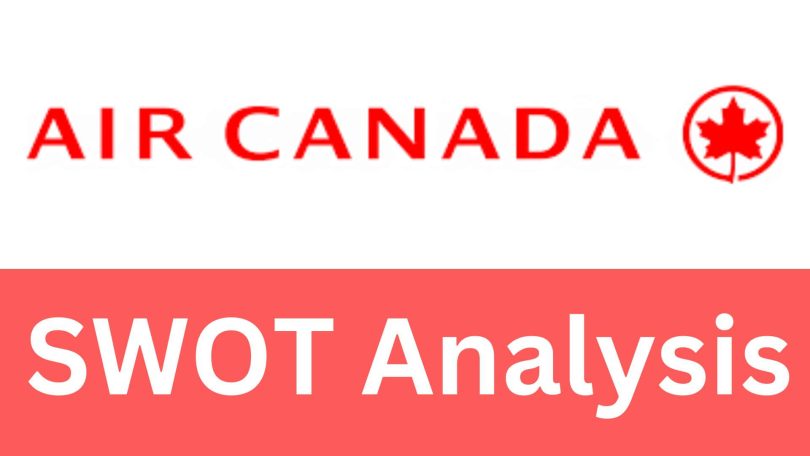Air Canada faces numerous challenges and opportunities in today’s fast-paced aviation industry. So, we think conducting a fresh SWOT analysis is crucial for the airline’s management to understand its current position comprehensively.
This strategic management framework allows leaders to study internal strengths and weaknesses while evaluating external factors that could impact the business.
Using a SWOT analysis, Air Canada’s management can make strategic decisions aligning with the airline’s goals. This proactive approach enhances resilience and positions Air Canada for sustainable growth in an ever-evolving market.
SWOT analysis of Air Canada
We now turn to the results of Air Canada’s SWOT analysis:
The internal analysis of Air Canada
The main goal of an internal analysis for Air Canada is to gain a deep understanding of its strengths and weaknesses by evaluating its internal factors.
This self-assessment helps Air Canada’s management make informed decisions and develop effective strategies for the future.
Strengths of Air Canada
Air Canada possesses several strengths that distinguish it from its competitors in the airline industry. According to our research, we have found the following opportunities:
Market Leadership
Air Canada is the largest airline in Canada, holding a significant market share. As of May 2024, it has a market capitalization of approximately $4.84 billion.
This strong market position enables Air Canada to leverage its extensive route network and customer base to outperform competitors like WestJet and Porter Airlines, which primarily focus on domestic routes.
Diverse Fleet
The airline operates a mixed fleet of 187 mainline passenger aircraft, including Boeing, Airbus, and Bombardier models. This diversity allows Air Canada to efficiently serve a variety of routes and adjust capacity based on demand.
For instance, its fleet includes narrow-body jets for short domestic flights and wide-body jets for long-haul international travel, optimizing operational efficiency.
Strong Global Network
As a founding member of the Star Alliance, Air Canada benefits from an extensive global network that connects it to over 222 destinations across six continents.
This membership enhances its service offerings through codeshare agreements and joint ventures with other major airlines, allowing passengers to enjoy seamless travel experiences.
Financial Stability
Air Canada’s strategic management has resulted in robust financial stability, which allows it to navigate industry cycles effectively.
The airline’s focus on cost management and operational efficiency has strengthened its economic profile, enabling it to invest in new technologies and fleet modernization.
For example, the company has committed to purchasing 26 Airbus A321neo aircraft, which will enhance fuel efficiency and reduce operational costs starting in 2024.
Strong Loyalty Program
The Aeroplan loyalty program is one of Air Canada’s key strengths, boasting millions of members contributing to repeat business and customer loyalty.
This program rewards frequent flyers and enhances customer engagement, making it a critical component of Air Canada’s competitive strategy.
Commitment to Safety and Customer Service
Air Canada is recognized for its commitment to safety and high-quality customer service. The airline has consistently maintained a strong safety record, crucial for building trust among travelers.
Additionally, investments in customer experience enhancements—such as improved in-flight amenities—further solidify its reputation in the competitive landscape.
These strengths collectively position Air Canada as a formidable player in the airline industry, enabling it to compete effectively against traditional carriers and low-cost airlines.
Weaknesses of Air Canada
Air Canada faces several weaknesses that impact its competitive position in the airline industry.
High Dependence on the Canadian Market
Air Canada generates a significant portion of its revenue from domestic travel, making it vulnerable to economic fluctuations and regulatory changes within Canada. This reliance limits its growth potential in international markets.
For instance, during the COVID-19 pandemic, travel restrictions heavily impacted domestic demand, resulting in an 80% decrease in revenue in the first half of 2021 compared to the same period in 2019.
Elevated Operating Costs
The airline suffers from high operating costs, which include fuel, labor, and maintenance expenses. In 2023, Air Canada reported $4.5 billion in net debt, constraining its financial flexibility and profitability.
Rising fuel prices can further exacerbate this issue; for example, a 10% increase in fuel prices can significantly impact profit margins due to the airline’s reliance on fuel for operations.
Vulnerability to External Factors
Air Canada’s operations are susceptible to uncontrollable external factors such as fuel price volatility and geopolitical events. Fluctuations in fuel prices can dramatically affect operational costs.
Further, events like the COVID-19 pandemic have shown how quickly external factors can disrupt travel demand and operations, leading to massive financial losses for the airline.
High Debt Burden
Air Canada’s significant debt load limits its ability to invest in fleet modernization and operational improvements. The company’s $4.5 billion net debt as of 2023 restricts financial maneuverability during economic downturns or periods of increased competition.
This debt burden can hinder strategic initiatives that require substantial capital investment.
Labor Relations Issues
Air Canada has experienced contentious labor relations, including strikes and disputes with unions representing pilots and other staff members.
Such conflicts disrupt operations and can lead to flight cancellations or delays, negatively impacting customer satisfaction and the airline’s reputation.
Aging Infrastructure
The airline’s aging fleet requires ongoing maintenance and modernization investments, which can strain financial resources.
Older aircraft have higher maintenance costs and may not meet newer environmental regulations without significant upgrades.
Customer Service Challenges
Air Canada has faced criticism regarding customer service issues such as lost luggage and delays. These complaints can damage the airline’s reputation and deter potential customers from choosing Air Canada over competitors known for better service quality.
These weaknesses highlight areas where Air Canada must improve its operations and strategic positioning to remain competitive in the evolving airline industry.
The External Analysis of Air Canada
The primary objective of conducting an external analysis for Air Canada is to understand external factors beyond its control that could influence its success in the global aviation industry.
This analysis helps Air Canada’s management make well-informed decisions regarding its strategy, operations, and future trajectory. The external analysis delves into two main aspects: opportunities and threats.
Let’s move on to Air Canada’s current and potential opportunities and threats without further ado.
Opportunities of Air Canada
Air Canada has several current and potential opportunities in the global airline market. These opportunities can help the airline enhance its market position and drive growth.
Expansion of Route Network
Air Canada can explore new domestic and international destinations to increase its market presence. The airline can meet evolving travel demands and attract a broader customer base by tapping into underserved markets.
For example, expanding routes into emerging markets in Asia and South America could unlock new revenue streams and enhance competitiveness against rivals like WestJet and American Airlines.
Focus on Emerging Markets
The airline industry is witnessing significant growth in regions such as Asia and South America, where air travel demand is rising. Air Canada can capitalize on this trend by increasing its market presence.
Recent data indicates that international travel from Canada to Asia has grown. Air Canada recently expanded services to destinations like Seoul and Tokyo, which positions the airline to benefit from increased passenger traffic in these regions.
Enhancing Digital Capabilities
Digital technologies can significantly improve Air Canada’s operational efficiency and customer experience. The airline can streamline operations, enhance decision-making, and optimize revenue management by leveraging data analytics, artificial intelligence, and automation.
This digital transformation is crucial in a competitive landscape where customer expectations rapidly evolve.
Strategic Partnerships and Alliances
As a founding member of the Star Alliance, Air Canada has access to an extensive global network through partnerships with other major airlines. Exploring new strategic partnerships can further enhance its operational efficiency and reach.
For instance, codeshare agreements with regional carriers or low-cost airlines could provide customers with more travel options and increase Air Canada’s market share.
Focus on Cargo Operations
The growth of e-commerce presents a significant opportunity for Air Canada’s cargo operations. By enhancing its cargo services and optimizing its route network for freight transport, Air Canada can capitalize on the increasing demand for fast and reliable shipping solutions.
This sector has become increasingly important, especially as global trade expands.
Sustainable Aviation Initiatives
With growing consumer awareness of environmental issues, Air Canada can differentiate itself by adopting sustainable practices. Investing in fuel-efficient aircraft and alternative fuels reduces environmental impact and aligns with consumer preferences for eco-friendly travel options.
This commitment to sustainability can enhance brand loyalty and attract environmentally conscious travelers.
Recovery from COVID-19 Pandemic
As travel demand rebounds post-pandemic, Air Canada can regain lost market share by capitalizing on pent-up demand for leisure and business travel. The airline can implement targeted marketing strategies to attract travelers eager to resume their journeys.
Diversification of Services
By expanding its service offerings—such as holiday packages, travel insurance, and hotel partnerships—Air Canada can create an integrated travel experience that enhances customer engagement and generates additional revenue streams.
Growth of Low-Cost Segment
Expanding Air Canada’s low-cost subsidiary, Air Canada Rouge, presents an opportunity to capture budget-conscious travelers. By targeting this segment effectively, Air Canada can increase its customer base while maintaining profitability through a lower cost structure.
These opportunities highlight areas where Air Canada can strategically position itself for growth in a competitive global airline market while adapting to changing consumer demands and industry trends.
Threats of Air Canada
According to our investigations, Air Canada faces various threats and challenges in the global airline market that could impact its operations and profitability.
Intense Competition
The airline industry is characterized by fierce competition from legacy carriers and low-cost airlines. Air Canada has recently lowered its earnings forecast due to increased competition in international markets, which has led to its planes flying with lower occupancy than anticipated.
This competitive pressure can result in price wars, adversely affecting profit margins and market share. For instance, Air Canada’s adjusted earnings before interest, taxes, depreciation, and amortization for 2024 is now projected to be between $3.1 billion and $3.4 billion, down from earlier estimates of $3.7 billion to $4.2 billion.
Economic and Geopolitical Factors
Global economic instability and geopolitical tensions can significantly affect air travel demand. Economic downturns typically result in decreased consumer spending on travel, which directly impacts airlines’ revenues.
The COVID-19 pandemic illustrated this vulnerability when travel restrictions led to a dramatic drop in passenger numbers. Ongoing geopolitical issues continue to pose risks that could disrupt travel patterns and reduce demand for Air Canada’s services.
Fluctuations in Fuel Prices
Air Canada is highly susceptible to fluctuations in fuel prices, which constitute a significant portion of its operating costs. Rising crude oil prices can increase operational expenses, squeezing profit margins.
For example, high fuel costs have been cited as contributing to Air Canada’s cautious outlook for 2024, as they continue to weigh heavily on the airline’s profitability.
Labor Relations Issues
Labor relations pose another threat to Air Canada’s operational stability. The airline faces ongoing negotiations with its pilots’ union, which has filed for federal conciliation assistance due to stalled talks over a new collective agreement that expired in September 2023.
Potential labor strikes or disruptions could significantly affect flight schedules and customer service.
Regulatory Challenges
Air Canada must navigate a complex web of regulations that govern the aviation industry. Changes in government policies, environmental regulations, or increased taxes can impose additional costs or operational constraints on the airline.
Compliance with evolving environmental standards is particularly critical as airlines face pressure to reduce emissions and invest in greener technologies.
Supply Chain Disruptions
The airline industry has grappled with supply chain challenges affecting aircraft deliveries and maintenance schedules. Air Canada has experienced knock-on effects from the recall of Pratt & Whitney turbofan jet engines for inspection and repair, which can limit fleet availability and operational capacity.
Moreover, delays from aircraft manufacturers like Boeing have constrained growth opportunities for Canadian airlines.
High Debt Burden
Air Canada’s significant debt load—approximately $12.48 billion—limits its financial flexibility and makes it more vulnerable during economic downturns or increased competition. This high level of debt can hinder the airline’s ability to invest in necessary upgrades or expansions.
These threats highlight the challenges Air Canada must navigate in a dynamic global airline market while maintaining profitability and competitive advantage amidst evolving industry conditions.
Air Canada SWOT analysis matrix
To summarize the results of the Air Canada SWOT analysis, we present the following SWOT matrix:

Conclusion
Air Canada has several strategic options to consider to ensure its sustainability and growth in the coming years. The airline is making significant strides toward sustainability by committing to achieve net-zero greenhouse gas emissions by 2050.
This ambitious goal includes interim targets for reducing emissions from flights and ground operations by 2030.
By investing $50 million in sustainable aviation fuels and exploring innovative technologies such as electric and hydrogen-powered aircraft, Air Canada can position itself as a leader in environmental responsibility, appealing to increasingly eco-conscious consumers.
Recognizing the growth potential in the cargo sector, Air Canada can diversify its revenue streams by converting older passenger planes into cargo aircraft and expanding its freighter fleet.
This strategic pivot enhances operational efficiency and leverages the airline’s extensive international network, particularly in the wake of rising e-commerce demand.
Investing in technology is another key focus for Air Canada. The airline can improve satisfaction and loyalty by developing digital tools that streamline operations and provide customers with more options and flexibility.
Embracing data analytics and automation innovations will optimize revenue management and enhance operational efficiency.
Strengthening partnerships within the airline industry, particularly through alliances like Star Alliance, can expand Air Canada’s reach and enhance its service offerings.
Collaborating with regional carriers and low-cost airlines will help tap into new customer segments and improve operational efficiency.
Moreover, exploring new routes in emerging markets, especially in Asia and South America, presents a significant opportunity for growth.
By expanding its presence in these regions, Air Canada can capture a larger share of international travel.
Finally, continuing to modernize its fleet with more fuel-efficient aircraft will reduce operating costs and align with sustainability goals. Introducing newer models like the Airbus A220 and Boeing 737 MAX will enhance fuel efficiency and lower emissions.
In summary, by prioritizing sustainability initiatives, expanding cargo operations, investing in technology, leveraging strategic partnerships, exploring emerging markets, and modernizing its fleet, Air Canada can navigate the challenges of the global airline market while ensuring long-term growth and resilience.
Read also: PESTEL analysis of Air Canada in 2024.
SWOT Analysis Examples 2024
There is no better way to understand how to conduct a SWOT analysis at your company than with a concrete example.
Below you will find our free, up-to-date, and concrete examples of SWOT analyses of large companies and multinationals conducted in 2024.












Leave a Comment